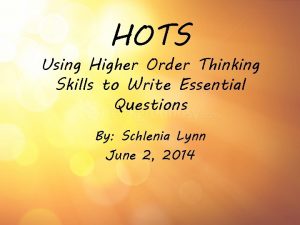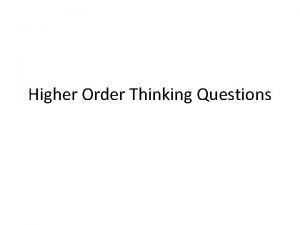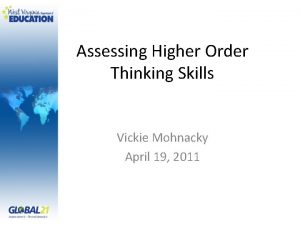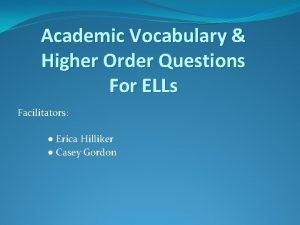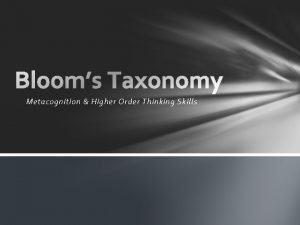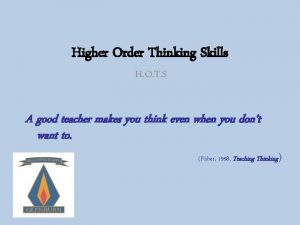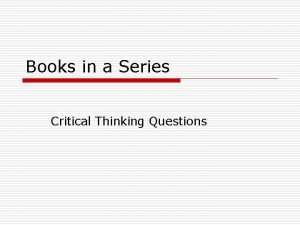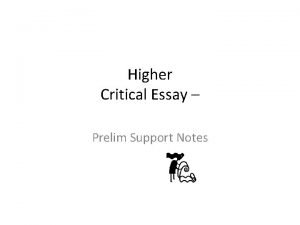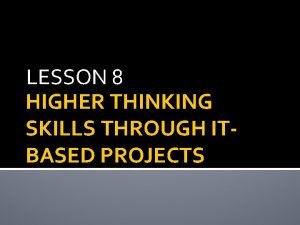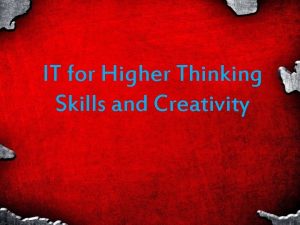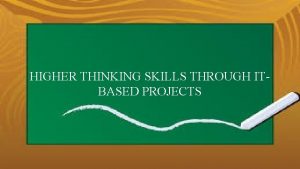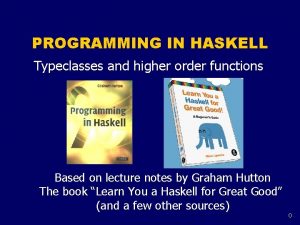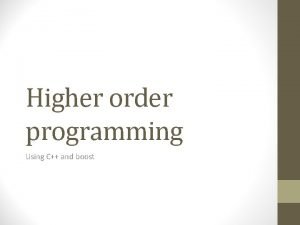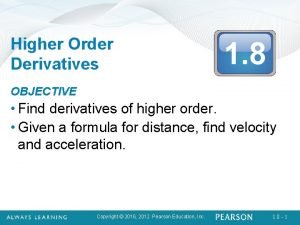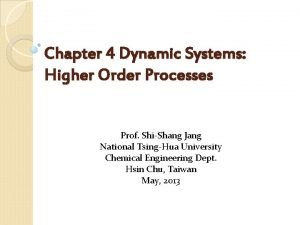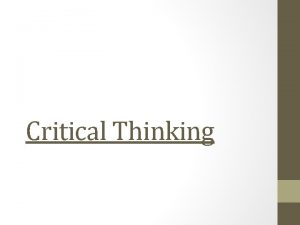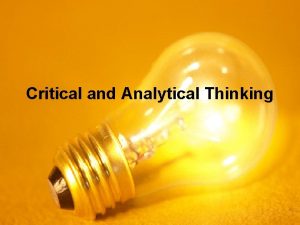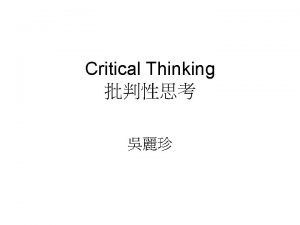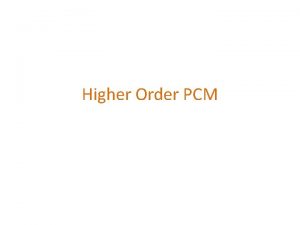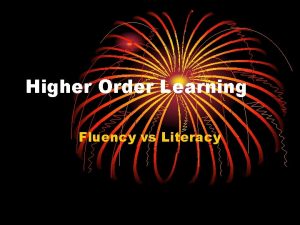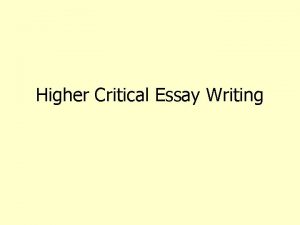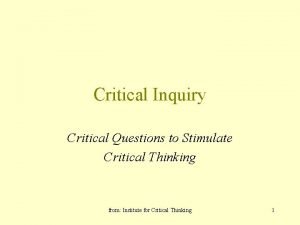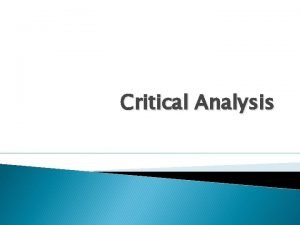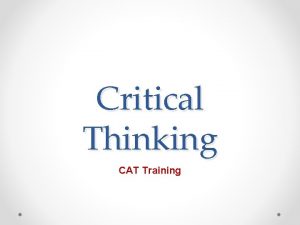Critical Thinking What is it Higher Order Thinking




















- Slides: 20

Critical Thinking What is it?

Higher Order Thinking Synthesize

Bloom's Taxonomy

Bloom's Taxonomy The first, most basic level of thought is called KNOWLEDGE. When you possess knowledge, you possess basic information. You fill your head with facts, figures, names, dates, places, etc. — remembering previously learned material.

Bloom's Taxonomy If you were to consider the topic of mathematics using Bloom’s Taxonomy, you would define KNOWLEDGE as remembering numbers—the ability to count from 1 to 100, but you would not understand how those numbers are useful. Knowledge: arrange, define, duplicate, label, list, memorize, name, order, recognize, relate, recall, repeat, reproduce state.

Bloom's Taxonomy Knowledge is followed by Understanding, the ability to grasp the meaning of material. It goes just beyond the knowledge level. Comprehension is the lowest level of understanding. Comprehension: classify, describe, discuss, explain, express, identify, indicate, locate, recognize, report,

Bloom's Taxonomy APPLICATION is the next level of the hierarchy and refers to the ability to use learned material in new and concrete ways, such as solving a particular problem. Application requires a higher level of understanding than comprehension. Application: apply, choose, demonstrate, employ, illustrate, interpret, operate, practice, schedule, sketch, solve, use, write.

Bloom's Taxonomy In ANALYSIS, the 4 th level of the taxonomy, the learning outcomes requires the ability to break the information into separate parts in order to gain a greater understanding of the whole. Analysis: analyze, appraise, calculate, categorize, compare, contrast, criticize, differentiate, discriminate, distinguish, examine, experiment, question, test.

Bloom's Taxonomy SYNTHESIS, the 5 th level of Bloom, refers to the ability to put parts together to form a new whole. and, finally, formulate new ideas from the patterns of information SYNTHESIS allows you to take the information you have collected through the analysis process and to pull in other information in order to formulate new ideas Synthesis: arrange, assemble, collect, compose, construct, create, design, develop, formulate,

Bloom's Taxonomy The last level of the taxonomy is EVALUATION. Evaluation is concerned with the ability to judge the value of material for a given purpose. The thought process in this area is the highest in the cognitive hierarchy because it incorporates or contains elements of the previous levels: knowledge, comprehension, application, analysis, and synthesis. In addition, this level contain conscious value judgments and arguements based on clearly defined criteria.

Bloom's Taxonomy This last level of the taxonomy, EVALUATION, empowers you to judge the value “Which is the best choice? What would be best for me, for others, or for my family? ” Evaluation: appraise, assess, choose compare, defend estimate, judge, predict, rate, select, support, value, evaluate.

Critical Thinking What is it?

Definition of Critical Thinking Critical thinking is analytical thinking in the pursuit of relevant and reliable knowledge about the world. It could be described as reasoned, reflective and skillful thinking that is focused on weighing evidence and argument then deciding what to believe or do.

Critical Thinking Critical thinking is higher-order thinking. It enables a person to make judgments about political or social issues. Critical thinking enables an individual to be a responsible citizen who contributes to society, and not be merely a consumer of society's propaganda.

Critical Thinking Critical thinking can also be described as the scientific method applied by ordinary people to the ordinary problems and issues. Critical thinking approximates the well-known method of scientific investigation: 1. a question or problem is identified, 2. the issue is defined and researched, 3. Evidence is weighed and evaluated, 4. a hypothesis formulated, 5. relevant data sought and gathered, 6. the hypothesis is logically tested and evaluated, and 7. reliable conclusions are drawn from the result.

Critical Thinking All of the techniques of scientific investigation are used in critical thinking, which is in essence scientific method used in everyday life. Critical thinkers investigate problems, ask questions, pose new answers that challenge the status quo, discover new information that can be used for understanding or judgments, question authorities and traditional beliefs, challenge received dogmas and doctrines.

A person who thinks critically will: define the issue or problem and gather relevant information; look at the issue or problem from multiple angles and ask appropriate questions; suspend judgment in the absence of sufficient evidence to support a decision; remain comfortable with ambiguity (understand the difference between “Truth” and “knowledge in progress; ” evaluate the validity of arguments, evidence and assumptions of alternative points of view or solutions; recognize the fallibility of their own opinions, the probability of bias in those opinions, and the danger of weighting evidence according to personal preferences; reason logically from information and evidence; and come to reliable and trustworthy conclusions, well supported by logic and evidence about the issue or

John Dewey and Critical Thinking In his book How We Think, John Dewey defined critical thinking as "reflective thought"- to suspend judgment, maintain a healthy skepticism, and exercise an open mind. These three activities called for the active, persistent, and careful consideration of any belief in light of the ground that supports it. In Dewey’s view students must be taught to examine, poke, question, and reflect on what they have learned. Skepticism, questioning, and reflection are essential. Examine a problem, find a solution, think about why you were or were not successful, and learn from your successes and failures.

John Dewey and Critical Thinking Dewey thought that all inquiry both about the physical universe and about ethical choices could equally be explored through the scientific method. That is, he thought we could make value judgments by applying reasoned inquiry. He suggested that the test for ethical choices should be “ends in view, ” or the projected consequences of alternative social action. So we should test our hypotheses about what we should do or not do in a situation of social choice (or personal choice) by the consequences of the action. He thought we could be scientific about making social choices or “value judgments. ”

Evaluation Criterion for Critical Thinking Elements: Analyzes Information Thoroughly = 4 Analyzes key information, questions, and problems clearly and precisely Sufficiently = 3 Adequately = 2 Analyzes key Analyzes some key information, questions, and problems accurately most of the time Evaluates arguments and Arguments and assumptions with assumptions Assumptions insight competently inconsistently Evaluates evidence Evaluates with insight and competently and inconsistently and Evidence for and accurately Identifies does not accurately conclusions made Identifies assesses and assesses Identify and implications conclusions, assesses implications, and conclusions, consequences of implications, and arguments consequences of arguments Uses deductive Use of Reasoning Uses deductive and/or inductive and Problem reasoning and Solving Skills problem-solving skills consistently skills competently skills inconsistently and with great and weakly proficiency Mostly is fair in Some indication of Avoids Personal Fair-mindedly evaluates evaluation of considering bias and alternative points of preconceived view and follows view with only view but shows notions where evidence minimal evidence of some bias & leads without bias preconceptions Minimally = 1 Is unable to analyze information, questions, and problems or does so superficially Is unable to evaluate arguments and assumptions or does so superficially Is unable to evaluate evidence or does so superficially and is unable to assess the conclusions, implications, and consequences of arguments Is unable to or infrequently uses deductive and/or inductive reasoning and problem-solving skills Regardless of the evidence or reasons, maintains or defends views based on biased views or preconceptions Total Score = Score
 Critical semi critical and non critical instruments
Critical semi critical and non critical instruments Principle of sterilization
Principle of sterilization Thinking skills hots
Thinking skills hots Higher order thinking question stems
Higher order thinking question stems Higher order thinking skills
Higher order thinking skills Higher order thinking questions for vocabulary
Higher order thinking questions for vocabulary Blues taxonomy
Blues taxonomy Affective domain of bloom's taxonomy
Affective domain of bloom's taxonomy Hots questioning
Hots questioning Maniac magee higher order thinking questions
Maniac magee higher order thinking questions Perbedaan critical thinking dan creative thinking
Perbedaan critical thinking dan creative thinking Via optica
Via optica Higher critical essay help
Higher critical essay help Critical reading meaning
Critical reading meaning Higher thinking skills through it-based projects
Higher thinking skills through it-based projects Guided hypermedia projects
Guided hypermedia projects Higher thinking skills through it based projects
Higher thinking skills through it based projects Higher order functions haskell
Higher order functions haskell Std bind
Std bind Higher order derivatives definition
Higher order derivatives definition Higher order systems
Higher order systems


